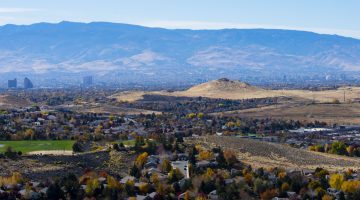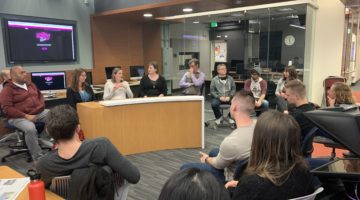By Alex Mocher
Beginning as early as the 4th century, according to asiasociety.org, mandalas have been created to symbolize the universe with an assortment of materials. Tibetan monks have historically used sand to create mandalas. After carefully designing the mandala, grain-by-grain, the monks conduct a ceremony and blow it away, recognizing the inevitable transition of material life.
Artist Nancy Hom prefers to use objects from the mini universe she is attempting to create. Last year she created her first 10 ft. mandala that represented her hometown of Oakland. After a friend of Paul Baker Prindle, director of university galleries, emailed Baker Prindle about the work Hom was doing, Baker Prindle asked Hom to make a mandala in Reno for the New Year.
“It would be very easy just to transport the mandala, but every one I do has to have the flavor of the place I’m going to,” Hom said. “Otherwise it wouldn’t have much meaning. You would go, ‘Oh that’s a nice mandala about Oakland and the Chinese new year,’ but you wouldn’t adopt it as your own.”
Hom combined her traditional Chinese past with the “flavors” of Reno to create another 10 ft. mandala that is currently being exhibited at the University of Nevada, Reno’s gallery Artspace, located in West Street Market.
To represent the New Year, Hom included red envelopes she reminisces on receiving when she was a child.
“They are traditionally given to children or people under a certain age, filled with money usually and parents give them to their kids for good luck for their year,” Hom said. “When I was growing up, we looked forward to new year’s day where we received these from parents and relatives.”
Hom adds that the Chinese also love to drink and gamble around the New Year, a pass-time she said the Chinese and people of Reno share. A roulette wheel has been placed in the middle of the mandala, surrounded by shot glasses.
“This is a mini world, and it is as if we’re taking a bird‘s-eye view of a universe that we make up,” Hom said. “The interesting thing to me is that no matter where you are in this little world, you know that you’re part of a bigger thing. Which is sort of like a spiritual worldview that you are part of a larger whole, and you all feed into the same center. I’m not saying we’re all roulette wheels, but the idea that we are all circling, and we are all contributing to a common goal. That’s what it really means to me.”
Besides the obvious gambling and alcoholic stereotypes of Reno, Hom wanted to include Reno’s past by inserting black and white historical mining photos she had UNR intern Priscilla Varner help her track down and print. By adding gold-coated railroad spikes, Hom honors the Chinese who helped to build the railroads that contributed to the expansion of the West.
The outside rings are reserved for reflecting what is currently happening in Reno, such as cutouts from Reno nightlife ads, photographs contributed by people living in Reno, as well as drawings created by those living in Reno.
“That’s the beauty of a mandala, is you do get to generate community just by talking to each other,” Hom said. “And whatever’s missing I always tell people, ‘Bring in what you think Reno is.’ It’s not fixed in stone. These are easily removed and replaced.”
The mandala will be on display in Artspace until March 28 on Thursdays, Fridays and Saturdays between 4 p.m. to 8 p.m. Contributions are still being accepted.
Alex Mosher can be reached at amosher@unr.edu.













